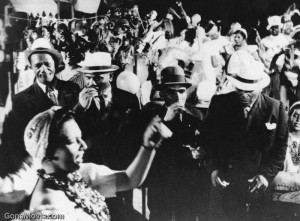Posted By Jonathan Rosenbaum on 03.23.07 at 08:07 PM
I’d like to beat the drum a little for a terrific new book just published by University of California Press, Catherine Benamou’s It’s All True: Orson Welles’s Pan-American Odyssey, which is far and away the definitive book on It’s All True, Welles’s doomed documentary project about Latin America in the 1940s. Maybe the fact that the same publisher is bringing out a book of mine about Welles in a couple of months gives me a special interest in the subject; I should also note that Benamou, who’s been working on her book for well over two decades, is an old friend. (She also arranged recently for the purchase of two major Welles collections by the University of Michigan, which are going by the name “Everybody’s Orson Welles.” I was privileged to be the first visitor to this mountain of material in Ann Arbor last summer, which is where I collected the stills used on my own book jacket.)
Some readers may be put off a bit by Catherine’s academic language, but the fact remains that so much fresh and even startling information is available here—information that corrects countless myths—that if you care about Welles at all, you can’t afford to ignore this book.
The received wisdom about It’s All True, commonly known as Welles’s Brazilian “misadventure,” is that he got so carried away by partying at the carnival in Rio that he cost RKO a fortune without any clear plan in mind for the film. Benamou fully demonstrates that virtually none of this scenario is true, and it can be attributed to the studio’s successful propaganda in justifying its firing of Welles — thereby dooming The Magnificent Ambersons as well as curtailing Welles’s equally ambitious three-part documentary feature, which would have had other segments filmed in Mexico and Peru.
In fact, if Welles was staying up most nights, this was partly in order to meet with his Brazilian collaborators (mainly performers and researchers) to plan the next day’s shooting, which would usually start around 8 AM. Arguably the true scandal of what he was doing was political — shooting a documentary whose major characters were all poor nonwhites, to the consternation of many government as well as studio officials.
Tags: Orson Welles, Catherine Benamou, It’s All True, Image

